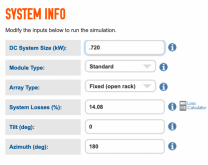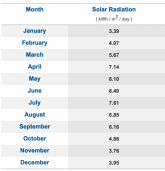basicrig
New Member
- Joined
- Dec 5, 2020
- Messages
- 17
Greetings.
I am a van dweller living in a cargo van. I have limited roof space, so solar panels are my limiting factor. I decided to max out my roof space with solar panels. I purchased two 360W modules, so that makes 720W total for solar panels. Here's a link to the specs for my panels.
Now, with 720W total, I'm trying to decide what sized battery bank I will need.
My location will be Phoenix, AZ during the winter. That's the worst case for which I must plan. According to the PVWatts Calculator, the PSH for Phoenix, AZ during December is 3.05.
Do the following calculations look correct?
PSH = 3.05 (Phoenix, AZ during December)
Total Panel Power = 720 W
720 W * 3.05 PSH = 2196 Wh produced from the panels
2196 Wh * 2 = 4392 Wh battery bank (for Lead Acid)
Since I can only charge 2196 Wh and since lead acid should only be discharged 50% I'm thinking that my battery bank should be double that. So, 4392 Wh total for lead acid batteries.
I am a van dweller living in a cargo van. I have limited roof space, so solar panels are my limiting factor. I decided to max out my roof space with solar panels. I purchased two 360W modules, so that makes 720W total for solar panels. Here's a link to the specs for my panels.
Now, with 720W total, I'm trying to decide what sized battery bank I will need.
My location will be Phoenix, AZ during the winter. That's the worst case for which I must plan. According to the PVWatts Calculator, the PSH for Phoenix, AZ during December is 3.05.
Do the following calculations look correct?
PSH = 3.05 (Phoenix, AZ during December)
Total Panel Power = 720 W
720 W * 3.05 PSH = 2196 Wh produced from the panels
2196 Wh * 2 = 4392 Wh battery bank (for Lead Acid)
Since I can only charge 2196 Wh and since lead acid should only be discharged 50% I'm thinking that my battery bank should be double that. So, 4392 Wh total for lead acid batteries.




